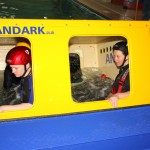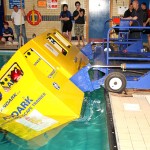Andark Training Day – 7th October 2012
On the 7th October, Staverton Flying School organised a trip to Andark in Swanwick for a ditching survival and life raft training course. Eight people attended the course including three from Staverton Flying School; Rowland Slatter, Richard Thwaites and Kim Hampshire.
Everyone met at the Andark Sports Shop and Pool Centre and there was a fair amount of nervous excitement as they anticipated the activities of the next two and a half hours. The course was run by the instructor, Jeff Emmerson, with the assistance of an operator to handle the ‘dunker’ and two underwater safety divers. The eight candidates were split into two teams; ‘The Pilots’ (the Staverton Flying School attendees with Jack Burch, a group owner of Robin G-BVMM) and ‘The Scientists’, (pilots from Natural Environment Research Council operating the Dornier on the Northern side of the Gloucestershire airfield).
The course started with the ditching survival training in the ‘dunker’. The ‘dunker’ is a cabin capable of seating up to 7 people with three windows and a sliding door. The whole cabin is hydraulically operated over a 3.5 meter deep pool to simulate a ditching into the sea. It is initially raised over the pool, dropped into the water and then rotated while being further lowered to simulate a landing on water, sinking and capsizing. The seating is fitted with either four point harnesses or lap straps. The window apertures can be left open or glazed with Perspex glazing which require removal before escaping through the openings.
cabin capable of seating up to 7 people with three windows and a sliding door. The whole cabin is hydraulically operated over a 3.5 meter deep pool to simulate a ditching into the sea. It is initially raised over the pool, dropped into the water and then rotated while being further lowered to simulate a landing on water, sinking and capsizing. The seating is fitted with either four point harnesses or lap straps. The window apertures can be left open or glazed with Perspex glazing which require removal before escaping through the openings.
Each team was given four runs in the dunker to experience; ditching with a capsize to 45°, then the same again but with glazing, followed by a 180° fully inverted capsize and finally a 180° capsize with glazing. The team members also swapped seats before each run so that each person experienced a window seat (first out) or an inner seat so that they had to wait while others got out before escaping themselves. This process of swapping seats also meant that everyone had the opportunity of experiencing escaping from different safety harnesses.
It was amusing to see each team, having successfully and uneventfully escaped the dunker themselves, line the pool with morbid curiosity as the other team was put through their paces. There were some very useful learning points to come out of the experience:
- Remain seated and strapped in during the capsize while water is sweeping in or you will get swept to the furthest extremity of the aircraft.
- It is surprisingly easy to become disorientated so keep the exit in site with one hand holding a handhold towards the exit and the other on the safety harness ready to release it once all water movement has ceased.
- Do not inflate any life jacket until out of the aircraft because escape will be nigh on impossible.
As a conclusion to the dunker training, some members of each team volunteered to take part in a further fully inverted, glazed escape run which, much to the disappointment of the rest of the attendees spectating, was executed without any hitches.
The next part of the course involved some basic water survival skills and life raft training. Everyone donned a life jacket and then jumped from a 6m high platform into the pool, inflated their life jacket and swam to the shallow end of the pool where Jeff demonstrated some basic cold water survival skills. These included a basic posture in the water to reduce body heat loss, forming a circle in the water with injured in the middle, forming a line and swimming in a particular direction under the guidance of a leader.
The life raft training involved learning how to right a capsized life raft and get aboard. Any myths about how easy it is to get into a life raft were quickly dispelled, even using the ‘ladder’. The training points were numerous:
- When righting a capsized life raft, point into wind and then hang onto the strap while it overturns onto the person righting it. The alternative is to end up with a glorified wind-surfer if trying to right it out of wind.
- Get the strongest person in first and he (she) can then help the others.
- Quickly erect the cover against spray and wind.
Each team was then given the task to jump into one end of the pool, link together and swim to the other end of the pool and back, then right the life raft and get everyone into it. There were sprinklers in the roof of the building spraying water while all this was going on. However those sprinklers were nothing compared to the jets of water directed on the teams by the other team that was spectating at this time.
Both teams met in the pub afterwards for a well earned drink and snacks before returning home. The unanimous verdict was that they had had a fun day out but all had learnt extremely useful tips to surviving a ditching in the sea.


